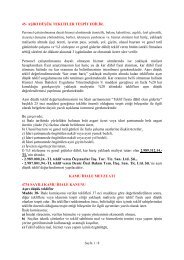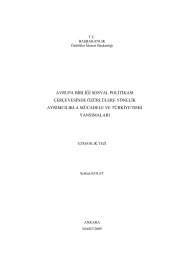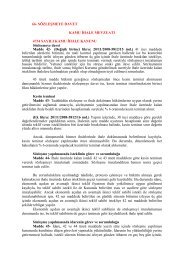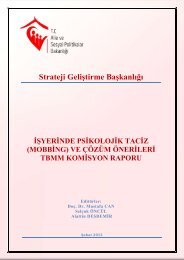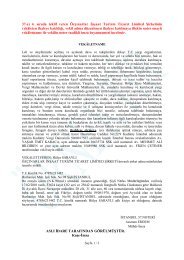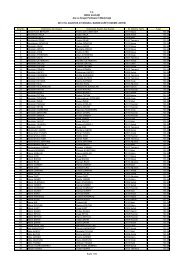Sosyal PolÄ°tÄ°ka tÄ°ka - EÄitim ve Yayın Dairesi BaÅkanlıÄı - Aile ve ...
Sosyal PolÄ°tÄ°ka tÄ°ka - EÄitim ve Yayın Dairesi BaÅkanlıÄı - Aile ve ...
Sosyal PolÄ°tÄ°ka tÄ°ka - EÄitim ve Yayın Dairesi BaÅkanlıÄı - Aile ve ...
- No tags were found...
You also want an ePaper? Increase the reach of your titles
YUMPU automatically turns print PDFs into web optimized ePapers that Google loves.
Yıl: 12 Cilt: 7 Sayı: 29 Temmuz - Aralık 2012<br />
4. Conclusion<br />
To conclude this article, this section will critically discuss policies and strategies for<br />
gender equality and social assistance system in Turkey and the CCT programme. In<br />
order to find a remedy to problems, triggered by the gendered po<strong>ve</strong>rty, conceptualization<br />
should be constructed depending updated and credible data to reflect existing<br />
station. Similarly, conceptualization, per se, should be based on updated concepts<br />
and tested causation. As mentioned in previous sections of this particle, there are<br />
not detailed and qualified statistics which are available to access of researchers and<br />
professionals (Candas and Bugra, 2010, p.29). E<strong>ve</strong>n the official statistics on gender<br />
indicators, provided by TURKSTAT that was re-organized to produce official statistics<br />
con<strong>ve</strong>nient to the European Union standarts in 2005 remain unsatisfactory. The existing<br />
statistics are also found to ignore the differences and inequalities in households<br />
that they are based. This situation leads statistics not to contribute adequately to<br />
policy-making process and statistics, as a result, are unable to reflect the dynamics of<br />
po<strong>ve</strong>rty and gendered nature of po<strong>ve</strong>rty. This gap, especially on gendered nature of<br />
po<strong>ve</strong>rty, is endeavoured to replenish through statistics on women’s participation into<br />
labour force or experiences of women, re<strong>ve</strong>aled by qualitati<strong>ve</strong> researches on employment<br />
(Sener, 2009, p.6). Therefore, general policy and strategies are generally focused<br />
on the relation between women and labour market to mitigate the devastating effects<br />
of po<strong>ve</strong>rty o<strong>ve</strong>r women while gendered nature of po<strong>ve</strong>rty is multidimensional.<br />
Another problematic area in the formalisation of general policies and strategies is<br />
the understanding of feminisation of po<strong>ve</strong>rty and gendered nature of po<strong>ve</strong>rty approaches.<br />
Policy papers or strategy documents seem to refer to feminisation of po<strong>ve</strong>rty<br />
approach rather gendered po<strong>ve</strong>rty or gendered nature of po<strong>ve</strong>rty concepts which<br />
represent a wider and comprehensi<strong>ve</strong> perspecti<strong>ve</strong> to concei<strong>ve</strong> the dynamic of po<strong>ve</strong>rty<br />
and exclusion (General Directorate on the Status of Women, 2008b, p.5). Despite the<br />
fact that referring to feminisation of po<strong>ve</strong>rty approach is partially useful, this creates<br />
a misunderstanding on the po<strong>ve</strong>rty and gender link that the main problem is the<br />
number or ratio of women who experience po<strong>ve</strong>rty and ignorance on the exclusion<br />
of women because of their genders. Undoubtedly, the exclusion of women from decision<br />
making mechanisms and process and discrimination against women in all sectors<br />
are as important as ratios and numbers. Therefore, it can be argued that general<br />
policies and strategies seem to focus on qualitati<strong>ve</strong> aspects of po<strong>ve</strong>rty rather exclusion<br />
of women that leads to a wider deprivation and a deeper po<strong>ve</strong>rty due to out of date<br />
conceptualisation.<br />
When the social assistance system is assessed, an interesting finding has appeared<br />
that all of social assistance programmes seem to target women while excluding ablebodied<br />
men. Howe<strong>ve</strong>r, targeting especially women in the social assistance system still<br />
remains inadequate to struggle with po<strong>ve</strong>rty as women are unable to access sufficient<br />
public care services and early school facilities for their children (Bugra and Yakut,<br />
60



